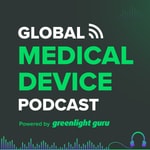Global Medical Device Podcast powered by Greenlight Guru – Details, episodes & analysis
Podcast details
Technical and general information from the podcast's RSS feed.

Global Medical Device Podcast powered by Greenlight Guru
Greenlight Guru + Medical Device Entrepreneurs
Frequency: 1 episode/5d. Total Eps: 350

Recent rankings
Latest chart positions across Apple Podcasts and Spotify rankings.
Apple Podcasts
🇫🇷 France - medicine
26/07/2025#92🇫🇷 France - medicine
25/07/2025#80🇫🇷 France - medicine
24/07/2025#53🇫🇷 France - medicine
29/04/2025#93🇫🇷 France - medicine
28/04/2025#55🇬🇧 Great Britain - medicine
26/04/2025#70🇬🇧 Great Britain - medicine
25/04/2025#87🇫🇷 France - medicine
10/04/2025#79🇨🇦 Canada - medicine
24/02/2025#97🇬🇧 Great Britain - medicine
19/02/2025#99
Spotify
No recent rankings available
Shared links between episodes and podcasts
Links found in episode descriptions and other podcasts that share them.
See all- https://www.projectmedtech.com/
174 shares
- https://www.medtronic.com/
73 shares
- https://www.greenlight.guru/
64 shares
RSS feed quality and score
Technical evaluation of the podcast's RSS feed quality and structure.
See allScore global : 52%
Publication history
Monthly episode publishing history over the past years.
#380: Navigating the Complex World of Combination Products with Subhi Saadeh
Episode 380
vendredi 30 août 2024 • Duration 38:53
In this episode of the Global Medical Device Podcast, Etienne Nichols sits down with Subhi Saadeh, host of the Combinate Podcast and an expert in the field of combination products.
They explore the complexities of combination products—those that integrate drugs, devices, and biologics—highlighting the regulatory challenges and industry growth.
Subhi shares his personal journey in podcasting, the impact of consistent content production, and the importance of lifelong learning.
They also dive into the intricacies of combination product definitions, regulatory pathways, and trends, offering listeners a well-rounded view of the current state and future potential of this evolving industry.
Key Timestamps:- [00:02] – Introduction of Subhi Saadeh and his background in combination products.
- [03:45] – The origin story of the Combinate Podcast and its impact on Subhi’s career.
- [12:32] – Overview of combination products and regulatory differences between the US and EU.
- [18:50] – Common misconceptions in drug-device integration.
- [28:10] – The evolving landscape of combination products and industry growth.
- [34:22] – Balancing technical and business aspects in MedTech.
- [46:15] – Notable episodes and guests from the Combinate Podcast.
- [56:30] – Final thoughts on lifelong learning and producing valuable content.
Quotes:
- Subhi Saadeh: "If I want to be a master at my craft, I need to be producing something in a way that is consistent."
- Etienne Nichols: "Teaching others is one of the best ways to instill that knowledge into yourself."
- Subhi Saadeh: "Drugs and devices aren’t as different as people think; it’s how they measure product quality that varies."
References:
- Combinate Podcast: let’s combinate.com
- Subhi Saadeh’s LinkedIn Profile: Connect with Subhi
- FDA Regulatory Guidelines for Combination Products: Important for understanding the regulatory landscape.
- Book Reference: Quality is Free by Philip Crosby - A must-read for quality management professionals.
- Book Reference: Bottle of Lifes by Katherine Eban
- Etienne Nichols’ LinkedIn Profile:
#379: Meet the Guru - Navigating Quality Management in Early-Stage Medical Device Companies and other Insights from a Veteran Engineer
Episode 379
jeudi 15 août 2024 • Duration 36:08
Explore the essential role of quality management in small medical device companies with Vernon Baker, a seasoned engineer. Learn about core QMS activities, regulatory intelligence, effective communication with top management, and key skills for aspiring quality managers. Gain valuable insights on supplier management, risk assessment, and regulatory compliance for startups and growing medical device firms.
#371: Achieving ISO 13485 Certification
Episode 371
mardi 28 mai 2024 • Duration 45:35
In this episode of the Global Medical Device Podcast, host Etienne Nichols chats with Weronika Michaluk and Zach Markin from HTD Health about their journey to achieving ISO 13485 certification. The discussion covers the importance of gap analysis, the value of a compliant agile approach, and the benefits of using Greenlight Guru’s eQMS software. Listeners will gain valuable insights into maintaining compliance and continuous improvement in the MedTech industry, as well as practical advice for navigating ISO 13485 certification.
Key Timestamps- 00:00 - 02:00 - Introduction by Etienne Nichols
- 02:00 - 05:30 - Introduction to HTD Health and their focus
- 05:30 - 10:45 - Discussion on the importance of ISO 13485 certification
- 10:45 - 14:30 - Steps and preparations for achieving ISO 13485 certification
- 14:30 - 20:00 - Benefits and features of using Greenlight Guru’s eQMS
- 20:00 - 25:00 - Challenges and changes faced during the certification process
- 25:00 - 30:00 - Practical tips for preparing for an ISO 13485 audit
- 30:00 - 35:00 - Continuous improvement and future goals for HTD Health
- 35:00 - 40:00 - Closing thoughts and advice from Weonika Michaluk and Zach Markin
Notable Quotes
- Weronika Michaluk: "Do a proper gap analysis and also think whether you have enough knowledge internally... it will make your life easier to reach out to a partner or consultant."
- Zach Markin: "In services, there’s not one ideal agile, but the right flavor of agile for the work that needs to be done."
- Weronika Michaluk: "Using Greenlight Guru made our lives easier, especially in managing traceability and ensuring compliance."
Key TakeawaysPractical Tips for MedTech Enthusiasts
- Gap Analysis: Conduct a thorough gap analysis to understand current capabilities and areas needing improvement.
- Internal Expertise: Ensure you have the necessary internal expertise or consult with experienced partners.
- Continuous Improvement: Regularly update and improve your processes to maintain compliance and efficiency.
References
- ISO 13485 Certification: Learn about the ISO 13485 standard for medical devices
- Visit Greenlight Guru for eQMS software solutions
- HTD Health
- Weronika Michaluk on LinkedIn
- Zack Markin on LinkedIn
- Connect with Etienne Nichols on LinkedIn.
MedTech 101Explainer for New Listeners
ISO 13485: An international standard that outlines the requirements for a quality management system specific to the medical device industry. It ensures that organizations consistently meet customer and regulatory requirements related to medical devices.
QMS (Quality Management System): A structured system of procedures and processes covering all aspects of design, manufacturing, and distribution to ensure products meet regulatory standards and customer expectations.
CAPA (Corrective and Preventive Action): A process within a QMS to investigate and correct the root causes of identified issues and prevent their recurrence.
Audience EngagementPoll QuestionWhat MedTech innovation are you most excited about?
Email your thoughts to
Building Your Regulatory Strategy for Commercialization
Episode 280
mercredi 14 septembre 2022 • Duration 43:50
What should early-stage entrepreneurs and medtech companies consider with commercialization in relation to how regulatory strategy affects business roadmap, pitfalls companies fall into, and fundraising efforts?
In this episode of the Global Medical Device Podcast, Etienne Nichols talks to Duane Mancini, CEO and Managing Partner at Project Medtech. Duane has experience in go-to-market strategy, including regulatory and reimbursement, biocompatibility, pre-clinical efficacy testing, and clinical trial design and execution. He has developed a comprehensive understanding of what early-stage startups need to do to be successful.
With all of the complexities of running a medtech company and taking a product to the market, Duane has seen a huge variation in how startups develop strategies and milestones. In this episode, we discuss how early decisions impact other aspects in the future and how companies can create a blueprint to build and grow long-term.
Some of the highlights of this episode include:- Fundraising: Figure out who you want to raise capital from, what should be in your pitch deck, and what questions will investors ask about problems/solutions.
- When trying to raise money, startups need to know that there are three types of investors—good, neutral, and bad. Sometimes, bad investors are hard to spot.
- When considering acquiring a company, some of the top things strategics look at is how you capture more clients, build your team, incorporate a quality management system (QMS), and handle regulatory challenges.
- If you are selling products to a hospital system, you will need to check three things—physician/clinician (especially nurses) ownership, patient improvement, and economic benefit.
- Build, develop, and invest in your team by finding people who complement your weaknesses. Don’t be afraid to fractionalize. One of the most important thing you can do for your company is to find advisors, partners, and mentors with large professional networks.
- When people are raising money, unless you are raising from a high net worth individual or angel group, be strategic with who you want to raise money. Venture Capitalists have a responsibility to spend (invest) their money just like you have a responsibility to raise it.
- Clients need to understand that regulatory fits into their business, clinical, reimbursement, and commercialization strategies—all those things work together and overlap, so make sure to ask the right questions to the right expert.
Memorable quotes from Duane Mancini:
“The #1 thing we try to tell all of our startups when they’re going out to raise money is there’s three types of investors. There’s good, neutral, and bad. You really want to avoid bad.”
“For those first few investors, you want to find a good investor. Someone who’s going to bring something else to the table. Fill a knowledge or network gap that you don’t have. Understand what your mission is for the company and how they are going to support it.”
“We talk to a lot of investors and a lot of entrepreneurs, and the one thing we’ve learned is that there is more than one way to raise money. However, there are patterns.”
“Regulatory fits into your business strategy, fits into your clinical strategy, fits into your commercialization strategy—all those things work together and overlap.”
Links:Packaging Validation Best Practices
Episode 279
mercredi 7 septembre 2022 • Duration 37:54
The packaging of medical devices, especially sterilized products, is often overlooked and does not make news headlines until it’s done wrong. How can packaging and labeling prevent 510(k) delays?
In this episode of the Global Medical Device Podcast, Etienne Nichols talks to Jeff Barrett, CEO of J-Pac Medical, about packaging validation best practices.
Jeff has 25 years of experience in the medical device industry, specializes in getting new devices to market, and scaling your commercialization. He has extensive knowledge and understanding of ISO 11607-1 & -2, Packaging for Terminally Sterilized Medical Devices.
Some of the highlights of this episode include:- Sterilization validations/revalidations take a lot of money ($40,000-80,000) and a long time (16-20 weeks) to complete.
- Don’t underestimate labeling - 40% of FDA recalls are due to labeling. Make sure your CM has good labeling controls.
- Over a third of all package validations fail the lab test for transit. The biggest reason why companies fail packaging validation is not understanding the various shipping modes and their related testing.
- ISO’s 11607 standard has two parts: Part 1 is about designing the package; Part 2 is validating the package. Also, there is a guidance document due to the complexity of the packaging process.
- The criteria for filing a 510(k) and steps related to packaging include validating that the seals are good from a sterile barrier standpoint and the product is good and has not changed over time because of transit testing or aging.
- From a design standpoint, document how the package has been designed and meets customers’ needs. Recently, the FDA added user testing to the standard for sterile transfer.
- Feasibility testing of prototypes and samples of vibration, drops, and humidity should be conducted to prevent potential problems. Ask engineers about product changes and the risks for redesign of packaging to know if the package will fail or pass.
Memorable quotes from Jeff Barrett:
“The FDA looks at a standard called ISO 11607. That is the Bible for medical device packaging validation. There’s two parts to it, Part 1 and Part 2. Part 1 is all about designing the package and Part 2 is about validating the package.”
“Over a third of all package validations failed at the lab for transit. It’s staggering.”
“Less so do we see damage to the product itself. So, I’d say, 8 out of 10 times on these failures, it’s the product and the seal failing, not the product breaking.”
“One of the biggest problems we see is, (the FDA) they don’t do any validation. They say, ‘We’re going to do it later.’ That’s obviously a problem. You can’t market the product if the package hasn’t been validated. That’s why the FDA gives you a break on that.”
“The bottom line is you’re trying to maintain the product without getting damaged and without the sterile barriers getting damaged. That is the end goal.”
Links:Overcoming Submission Deficiencies due to Biocompatibility
Episode 278
jeudi 1 septembre 2022 • Duration 29:54
What are submission deficiencies due to biocompatibility and how do medical device companies overcome them in trials, studies, and regulatory post-market surveillance?
In this episode of the Global Medical Device Podcast, Etienne Nichols talks to Chris Parker, Associate Department Head of In-Vivo Biocompatibility at Toxikon Corporation on how to overcome and prevent those submission deficiencies.
Some of the highlights of this episode include:- When a manufacturer puts their package together for a submission to the FDA, if it is not approved, then the FDA issues a deficiency or request for additional information due to a question or issue with some part of the submission.
- If a deficiency is issued, the FDA allows the manufacturer to handle it in one of two ways—either correct it through a memo/risk assessment or retest.
- It is better to be proactive rather than reactive when addressing a deficiency. A little bit of time upfront with the FDA will save a lot of time on the backend.
- Competition: When most medical devices are being developed, there is intent. Either it’s a completely new idea or existing product that another manufacturer offers that you want to build or improve upon.
- Prop 65 and new European regulations strive to keep out carcinogens, mutagens, reproductive toxins, and other compounds that at certain thresholds may be of concern and should not be included in devices or labeling is required.
- When it comes to quality, ISO standards and FDA regulations are in the best interest of the patient but may be a costly burden for the manufacturers. It takes units of a medical device to complete evaluations for biocompatibility testing.
- It takes days, months, or requires extensions for some companies to do remedial work and meet expectations when responding to a deficiency.
- Implement quality from the beginning with a quality management system (QMS) to understand expectations of standards, practices, and regulations.
Memorable quotes from Chris Parker:
“In a fair number of instances, there are cases where the FDA issues what we call a deficiency. It’s otherwise known as a request for additional information. But generally, what it is, is they have a question or an issue with some part of the submission.”
“Be proactive, not reactive because then a little bit of time upfront will save you a lot of time on the backend.”
“A lot of devices, when they are being developed, you’re doing it with intent in mind. Either it’s a completely novel, new idea or you saw a product and you said there’s a greater market than a particular other manufacturer offers, we want to jump into it or we want to improve it.”
“Let’s try to keep out anything of potential concern that we can at any concentration.”
Links:FDA - Overview of Device Regulation
FDA - Select Updates for Biocompatibility of Certain Devices in Contact with Intact Skin
Does Your CAPA Process Need a CAPA?
Episode 277
mercredi 24 août 2022 • Duration 51:49
Have you done Corrective and Preventive Actions (CAPA) on your CAPA process? If not, you need to seriously consider doing so because CAPA is the #1 reason why companies get 483 observations year after year.
In this episode of the Global Medical Device Podcast, Jon Speer talks to Mike Drues of Vascular Sciences about whether your medical device company’s CAPA process needs a CAPA. Why are medical devices companies continuing to struggle with CAPAs?
Some of the highlights of this episode include:- Only 3-5% of adverse events of medical devices are actually reported to the manufacturer or FDA. People tend to report every little event as a CAPA or report nothing at all.
- The five most common reasons why the FDA issued 483 observations and warning letters over the last 5 years were CAPAs, customer complaints, purchasing controls, medical device reporting, and process validation.
- If CAPA is the #1 reason why companies are getting 483 observations and warning letters, it may be due to an ineffective quality management system (QMS).
- Things happen every day during the course of running a business. Processes and routines may not go routinely. When something happens unexpectedly, will it happen again? What are you changing to ensure it does not happen again?
- CAPAs continue be the #1 reason because people do not have a common sense understanding of the quality system regulation. They focus on the words, but do not try to understand the meaning.
- CAPAs often generate negative connotations—the process requires extra work and more resources, not in the budget, and time pressure. However, people should view CAPA’s as an opportunity to improve a product and prevent problems in the future.
- People do not follow procedures because sometimes they don’t even know that procedures exist, or those procedures are not updated/revised after events.
Memorable quotes from this episode:
“A CAPA is an opportunity to really do a deep dive investigation to determine, is there a systemic issue that is influencing that process that you are following?” Jon Speer
“People don’t focus on the common sensical understanding.” Mike Drues
“Unless regulation makes sense, I don’t care what the regulation is, unless it makes sense, it is not good regulation.” Mike Drues
“Part of going through the CAPA procedure is to identify the root cause of the problem.” Mike Drues
“Only 3-5% of adverse events of medical devices are actually reported to the manufacturer or to the FDA.” Mike Drues
Links:FDA - Corrective and Preventive Actions (CAPA)
FDA - Form 483 Observations and Warning Letters
UDI and the Current State of Global Implementation
Episode 276
jeudi 18 août 2022 • Duration 45:47
What is the current state of unique device identification (UDI) in the United States versus the European Union (EU)? What are the current deadlines, complexities, and differences, as well as the four quadrants of UDI that companies need to be aware of? Don’t underestimate your time to comply because it always takes longer than expected.
In this episode of the Global Medical Device Podcast, Etienne Nichols talks to Gary Saner, Senior Manager of Information Solutions for Life Sciences at Reed Tech, about UDI and the current state of global implementation.
Gary has been helping companies achieve UDI compliance on a global scale for years. He is considered to be a thought leader and recognized authority on medical device UDI compliance.
Some of the highlights of this episode include:- As the U.S. FDA Class I UDI deadline approaches, companies should refer to the FDA’s final guidance, which describes the compliance policy regarding Global Unique Device Identification Database (GUDID) submission requirements for certain Class I devices considered consumer health products.
- Delays seem to be a part of the history of UDI. Manufacturers face challenges and pitfalls from UDI being rolled out easily. There are a number of issues with the brand new requirement in the United States.
- The four quadrants of UDI are identifying a product, reprocessed/reused products, reporting attributes, and documenting standard operating procedures (SOPs) in a quality management system (QMS).
- The EU has a complicated UDI implementation schedule, as well. Delays have been announced, but the impact was due to the European Commission completely revamping the regulatory platform.
- In Europe, UDI becomes one of the many things that a manufacturer has to learn, be educated on, and respond to. There’s no grandfathering of products, notified bodies, and patients. Portfolios are re-evaluated to meet new regulations.
- With the FDA and EU in place, the regulatory landscape typically uses one or the other as a precedent. Some health authorities around the world base their policies on one or the other. However, good global harmonization is not in place.
Memorable quotes from Gary Saner:
“This is a challenge in that this particular dataset has never really been assembled before. So, there’s no precedent for this.”
“The other issue is sometimes you find the data and it’s not accurate or it hasn’t been touched for a while. It’s not current. It’s obsolete. There’s issues with formatting. Sometimes, the formatting of that data that’s held for internal processes is not the format that actually gets submitted to the FDA.”
“There’s a little bit of a nuance about making sure the acknowledgements that come back from CDRH, there’s three acknowledgements, and making sure that they’re all complete for every single record.”
“UDI becomes one of the many things that a manufacturer has to learn and be educated on and then respond to and there was no grandfathering of products.”
“With the FDA and EU in place, the regulatory landscape typically uses one or the other as a precedent. Some of the other health authorities around the world will kind of base their policies on one or the other - US or EU.”
Links:The Changing Job Market & How It Affects Careers for MedTech Quality Professionals
Episode 275
mercredi 10 août 2022 • Duration 49:24
How is the changing job market affecting careers for professionals in MedTech? How can video storytelling strategies and techniques impact talent access?
In this episode of the Global Medical Device Podcast, Etienne Nichols talks to Joe Mullings, chairman and CEO of the Mullings Group companies, about finding true quality talent and celebrating excellence and hyper-competency to make lives better.
Joe’s search firm is responsible for more than 8,000 successful searches in the medtech/healthtech/life sciences industry. DragonFly Stories produces attention and awareness campaigns for companies globally through TrueFuture. TMG360 Media utilizes the power of media and outreach in medtech/healthtech to move businesses and health forward.
Some of the highlights of this episode include:- Quality of Outcome vs. Opportunity: Organizations are realizing that it’s much more expensive to lose and replace a good player rather than retain a good player. The quality and output of an employee’s work matters.
- Networking should occur when you don’t need it. Be clever, bring value, give and not take, and create a brand around yourself.
- The workforce and global economy has changed because of the worldwide pandemic. Things are starting to settle down, and it’s time to reset, re-define, and re-evaluate employees’ responses to work and fulfillment.
- WFX: Where are employees willing and wanting to work—from home, anywhere, or in the office—and how does that affect organizations’ willingness when it comes to compensation, flexibility, and the networking process to retain talent?
- Two-way communication between workers and employers needs to be created to find balance and reduce friction for healthy relationships. The catalyst for people switching or leaving their jobs is to make more money. However, top performers want to move forward in their career from their own developmental perspective and grow their skills.
- The non-negotiables of working in the office or not depends on your degree and years of experience. If you’re new, it’s best to work in the office to learn and mimic others. Then, it depends on your job function.
- The best way to represent yourself in the marketplace is based on your behaviors and how you package yourself when appearing in front of others.
Memorable quotes from Joe Mullings:
“We are the #1 search firm in the world, first of all, in the medical device/healthtech industry with more than 8,000 successful placements over three decades.”
“Compensation, right now, is also being driven by supply and demand.”
“You’ve got better career choices now, and you’ve also got the ability to live, potentially, a better life.”
“Let’s keep a better balance of power in the workforce instead of it being futile in nature where the companies call all the shots.”
“The digital scales your idiocy as well as your competency equally.”
Links:Digitizing your SaMD Testing
Episode 274
mercredi 3 août 2022 • Duration 51:00
What is software as a medical device (SaMD)? How does one test SaMD? What testing is required? What are the risks related to your SaMD and its testing?
In this episode of the Global Medical Device Podcast, Etienne Nichols talks to Rahul Kallampunathil, Vice President of Arbour Group’s Digital Compliance practice, about digitizing your SaMD testing.
Rahul builds teams that help companies proactively manage compliance risks toward a true digital enterprise. He is an innovative thinker with more than 18 years of experience in risk management, compliance, and internal controls focused on information technology and data.
Some of the highlights of this episode include:- Rahul defines SaMD as software used to perform a medical purpose without being part of a hardware medical device. SaMD is capable of running on any general purpose platform, such as your Android or iOS mobile phone.
- SaMD is different from software in a medical device (SiMD). SaMD is independent from hardware; SiMD is embedded in a physical medical device.
- Also, there’s differences between SaMD and medical device data systems (MDDS). MDDS only transfers, stores, or displays medical device data, but it does not have an algorithm or business rule to help make medical decisions.
- IEC 62304 impacts SaMD organizations and how they approach the risk of their solution. All SaMDs are not equal, and it’s important to understand the level of risk in every SaMD.
- Companies should prepare for SaMD testing with a clinical evaluation to demonstrate a valid clinical association between SaMD’s output and targeted clinical condition.
- Before thinking about designing and developing a product, a quality management system (QMS) should be established. Software companies need to adopt and modify their QMS to serve their product and its users, while fulfilling FDA requirements.
- Rahul discusses the pros and cons of manual versus automated/electronic documentation and testing, including risk management for patient safety.
- Best practices for SaMD testing are using agile and devops methodologies. Potential pitfalls are not testing continuously, even after the product is on the market.
Memorable quotes from Rahul Kallampunathil:
“Software as a medical device - it is software that is intended to be used for a medical purpose, and it performs that purpose without being part of a hardware medical device.”
“There is no physical device, in this case, that you can touch and feel. It’s purely software.”
“The nature of software - it’s something that you cannot touch or see. It’s all code. From a testing perspective, especially, there’s a lot of things that you need to pay attention to.”
“The quality management system or quality management process, that has to be established even before you think about the product, even before you design the product.”
Links:








